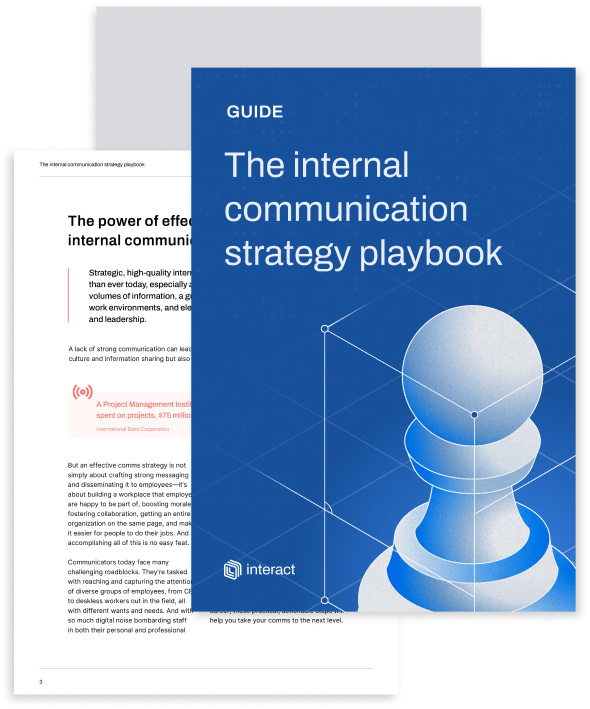The Great Resignation, The War for Talent, and International Stress Awareness Week: how do these factors tie together, and what do they mean for internal communicators? Let’s take a look at how each of these elements impact employee experience (EX), and how a modern intranet can help.
It’s International Stress Awareness Week – a period designed to spotlight the importance of stress prevention. It’s apt that this celebration of low stress should happen now, because tackling the causes of stress in the workplace is front of mind for employers as they weather this period of increased employee turnover labeled ‘The Great Resignation’. Internal communication can play a key role in reducing stress, improving EX, and reducing employee turnover, and this is where intranet software can also prove indispensable.
What is The Great Resignation?
The pandemic has impacted organizations in so many ways, one of which is a shifting of employee expectations. April 2021 saw more workers in the US quit their jobs than ever before, and economists began calling this ‘The Great Resignation’ or the ‘Big Quit’. Then, August saw an even greater number of people quit, and the volume of leavers has been rising in almost every industry.
What’s causing The Great Resignation? When lockdowns confined people to their homes, they found themselves with more time to think, and many will have spent this time re-evaluating the directions their lives were going in. Those who were forced to work from home gained extra income as commuting costs disappeared. Many were granted rent moratoriums, student loan forgiveness, and pandemic relief cheques, and all of this has given people the financial freedom to take greater risks, such as quitting a job they don’t love to search for one they do.
The difference between The War for Talent and The Great Resignation
‘The War for Talent’ is another term that appears to be interchangeable with The Great Resignation. So, are they one and the same, or do the terms differ? The truth is, The War for Talent is a product of The Great Resignation. As more people seek better opportunities, they are creating more open job vacancies by leaving their old positions and turning their noses up at opportunities that don’t meet their expectations. This has left organizations having to reconsider how they retain their existing people, and how they can make themselves more appealing than other employers when it comes to attracting talent.
An additional factor in the creation of a hyper-competitive market for the best employee talent is the progression towards remote and hybrid work. With a more global set of employers to choose from, employees have a wider range of options when it comes to who they can work for. This may mean that employees find it easier to leave jobs they’re disengaged from to take up new positions they would never formerly have been considered for.
Why employee experience matters more than ever

EX is exactly what it says on the tin. Just like customer experience (CX), an organization invested in EX concerns itself with how its people perceive their relationship with their employer, the company culture, and the work that they do. An organization that does EX well will do everything it can to keep people motivated, engaged, and productive.
Happy, engaged workers will stay with organization for longer, produce a higher quality of work, take fewer sick days, and treat customers better. Satisfied workers also contribute to a more positive company culture, which, in turn, will improve job satisfaction for others. Not only does all of this help the business achieve its goals, it means its people get to go home happier and more fulfilled, which contributes to increased happiness outside of work.
14 steps to great internal communications
How does all of this relate to International Stress Awareness Week? Combatting stress is an important factor in improving EX, which will help organizations fare better in The Great Resignation and The War for Talent, which, as we stated earlier, are both impacts of the pandemic. But two obstacles that have also spawned from the pandemic stand in the way of organizations reducing stress and improving EX to reduce churn and attract the best people.
Those obstacles are digital fatigue and the declining sense of physical community that workplaces provided in the pre-pandemic world. The digital employee experience (DEX) is an important factor here. Hybrid and fully remote working models have resulted in employees relying on more digital platforms to perform their roles. Navigating a growing number of applications, platforms, and communications can contribute to increased stress, even though they are intended to improve collaboration and productivity.
How modern intranets help improve employee satisfaction

One challenge for internal communicators is how to reach employees with messaging and resources to help manage stress without also contributing to it. As every internal communicator knows, there’s a fine line between sharing helpful, impactful messaging, and overwhelming employees with more information than they can process. A modern intranet effectively provides organizations with an employee engagement platform that helps them strike the right balance.
Some people still think of intranets as simple document management and storage systems, like SharePoint. In the early days of intranets, this is exactly what they were, but times have changed and so have intranets. A modern cloud-based intranet brings all of the tools and applications your internal communicators and employees need together in one place, which reduces the number of different platforms employees need to use, helping to ease digital fatigue.
A feature-rich modern intranet can become the home of an organization’s digital workplace. They provide tools and features that allow communicators to reach and engage with every employee across multiple channels. They also help everybody connect, collaborate, and contribute to a richer company culture.
Modern intranets can also provide internal communicators with data-backed intelligence that helps them understand how employees are engaging with content, which channels and types of content work for different people in the organization, and when employees are most receptive to different communications. All of this allows comms, and their delivery, to be tailored to different personas, and some intranets even allow employees to personalize their experiences even further, driving greater satisfaction.
Why motivation matters (and how comms can help)

It’s easy to view workplace stress as a problem that is simply too complex to solve, and organizations may instead choose to evaluate other factors, such as pay and benefits in a bid to reduce churn and attract new talent. While increased pay and improved benefits may help to some extent, what if organizations could help their people reduce stress at its source?
It may not seem like an obvious link, but research points to motivation as an important element in stress reduction. Of course, nobody is suggesting that employees are stressed because they are unmotivated, however, motivational cues in your communications can help to reduce stress and improve job satisfaction.
14 steps to great internal communications
Back in the 1980s, psychologist Frederick Herzberg theorized that job satisfaction can be broken down into two factors. These factors are ‘hygiene’ issues, such as salary and supervision, which can negatively impact satisfaction levels, and ‘motivators’, which include achievement and recognition, which increase satisfaction, productivity, creativity, and commitment.
So, do these motivators still hold true today? Future of Work expert Kim Seeling Smith recently published an article on keeping people happy, based on exit interviews held with 5,000 people over a 15-year period. Through her experiences, Seeling Smith has uncovered key modern motivators that can help to improve satisfaction for employees who may be feeling stressed. Let’s take a look at some of these motivators, and explore how a modern intranet can help internal communicators to embed them:
People are motivated when company values reflect their own
Employees expect an organization’s values and purpose should resonate with what they believe in. Dedicated pages on your intranet can provide employees with all the information they need on company values and purposes, with articles, discussion topics, and other related content. You can make these easy to find by creating a dynamic widget on your homepage screen that directs to your values and purposes content, as well as suggesting or pushing relevant content to your people using personalization functionalities.
Important updates to company values and purpose, or activities relating to either, can be shared with your people through timely broadcasts. Beyond functioning as an internal communications email platform, an intranet that supports multichannel messaging will help ensure these reach every employee through their own preferred channel, whether that’s SMS, push notifications on your intranet mobile app, digital signage, or email.
People are motivated by good relationships with their co-workers
It’s easy to get to know your direct team, but working relationships can be reinforced through your intranet using blog posts, discussion boards, forums, and social tools such as timelines, commenting, liking, sharing, polls, and the ability to tag individuals in comments and timeline posts.
But what about the people they may occasionally liaise with, but don’t get to know because they sit on the other side of the office, work in another building entirely, or work remotely? The above tools can help with this too, and a people directory with user profiles can also help employees understand who’s who, and what they do.
14 steps to great internal communications
People are motivated when their achievements are recognized
Praise and appreciation are top factors when it comes to motivating your people. This is where gamification elements, such as the ability to give recognition and rewards, can have a significant impact. At Interact, we give Donuts. They’re like our own digital currency, which everybody can give and receive to demonstrate recognition. Think Bitcoin, but less volatile.
While recognition may be universally appreciated, there is no tangible one-size-fits-all solution that ensures everybody is recognized with a reward that is meaningful to them. Interact employees can accumulate Donuts and, when they reach a certain monetary value, they can spend them on what they like, such as material items, or trade them for treats like half a day’s leave.
People are motivated when they are given a voice
Even if they don’t want to shout, every employee wants to have a voice, so it’s important to give them a platform. This is exactly what a modern intranet does, allowing your people to mention their team’s achievements, call out a co-worker who has gone above and beyond, have their say by answering company surveys, pose questions to the business, or make suggestions and recommendations.
Your intranet can provide additional value by giving people a voice on specific aspects of projects they’re working on, with dedicated project/team groups and spaces where everybody involved in a team or project gets to have their say.
People are motivated when they know how to succeed and understand how success will be measured
Clarity around roles and goals is important to your people and you can provide this by displaying your company mission front and center on your intranet homepage, and making it easy for people to find their job description, company hierarchy, or established processes and procedures. This can be achieved with a CMS intranet, a built-in document management system (DMS), or the ability to connect and integrate with a cloud-based storage system such as SharePoint, Dropbox, or OneDrive.
Reinventing the employee experience
Intranet software is a powerful tool for organizations that understand the importance and the challenges of providing outstanding employee experiences. Those adopting modern intranets will have a far easier job of reducing stress, improving satisfaction, and bringing everybody closer together in an age when employees’ expectations are on the rise, and organizations are becoming increasingly dispersed.


